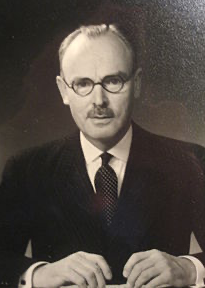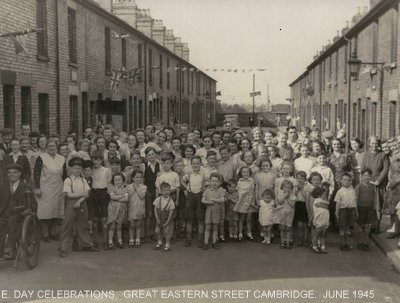Search by topic
- archaeology
- Building of Local Interest
- charity
- church
- crime
- dressmaker
- fire
- Great Eastern Railway
- Listed building
- Mapping Relief
- medieval
- oral history
- poverty
- Public House
- Rattee & Kett
- Religious House
- Roman
- scholar
- school
- Then and Now
- tudor
- women
- work
- world war one
- world war two
Search by text
51 Great Eastern Street
History of 51 Great Eastern Street
1939
Herbert B Sparkes, b 1891, LNER guard
Maud, M, b 1889
Irene Larham, b 1920, LNER Refreshment Room Asst.
In 2003 H Sparks sent the Museum his reminiscences of Great Eastern Street.
I was born in Great Eastern Street and am now 85 but full of memories of this area.
The Public House at the top of Great Eastern Street “The Earl of Beaconsfield” was always called “The Top” and opposite was a barbers shop on the corner of Argyle Street. Further down was what is now called the Broadway which in my day was brick wall. Opposite was the Baptist Church and we held a sports day on a field down Sedgwick Street. Beer at “The Top” was Worthington and 4d a pint. You had to go down steps to get into the main bar. The owner was Mr Fabb.
The Nursery school was in Catharine Street and then it was either St Phillip or Romsey School. I went to the latter until age 11 and then went to the Central School on Parkside. Our teacher at Romsey was a Miss Chapman and well known as Fanny and Toby Holt was the headmaster. I have a photo of Miss Chapman and our class which would be about 1927/8. There was no Coleridge Road as such but mainly fields which went to Cherry Hinton and dog racing was held on the left hand side of the road leading to Cherry Hinton. The bus service was Ortona and was 1d from Drummer Street to the Kinema or 1 1/2 if over Mill Road Bridge to the Standard Pub which was the terminal. The bus was No.2 which later became 102.
Going over the Bridge you came to the Library and you had to show you had clean hands before entering. Further along towards Railway was Dr Grange and I had help from him and his son Dr Grange who has now retired from surgery at Cherry Hinton.
At the corner of Kingston Street was a very smart tailors shop and opposite was another clothing shop (mainly children’s) called “Smart”. Down Kingston St was the “Grays” newspaper shop and for doing a round which took me to Centre Town 6 days for 3/6d a week and 1 shilling for Sunday. Further down was a well known locksmith called “Dents.”
I transferred from Baptist Church to St Barnabas and joined their Boys Brigade the 5th Co Cambridge and our hall was at the bottom of Covent Garden. We gave an exhibition at the Guildhall – Ipswich – Sawston etc. both in marching and gymnasium. The latter was run by a Mr Bendal who was a hairdresser by trade.
The two cinemas were the Kinema (Flea Pit) or Playhouse. The Kinema was 3d and the Playhouse 4d.
The Maternity Hospital in my day was a ‘workhouse’ and inmates had to chop wood and grow vegetables in the front of the building which was railed off from Mill Road. My son was born when it became a Maternity Hospital.
The bomb which hit Great Eastern Street was about 30 yards from our house but it cracked some of the wall.
The baths at the corner of Gwydir St we used every weekend at a cost of 6d. The soap was provided but we took our own towels. Each street had a football team and we played against each other. We were usually to exhausted to become yobos of today.
Near here the snooker hall was built by the famous Joe Davies and held twenty four tables. This place was always well attended. It later became a carpet shop. A bank was on the corner of Mill Road and St Barnabas Road and a cycle shop called “Eastmans” next to church. Mill Road bridge was later altered to take todays traffic.
After seven years in the RAF during World War II and after marriage we returned to Great Eastern Street until obtaining a pre-fab here in Cherry Hinton. Snakey Path was always the cyclist way to get to the bottom of Mill Road and used this several times a day.
Most of Romsey Town was made up of railway workers. the fencing at the bottom of our garden was made up of sleepers and which we hammered in great nails so that we could get onto the railway especially when playing hide and seek. Lots of sheds were built leaning on to the sleepers.
In Mill Road opposite what is now the Broadway was “Webbs” radio shop where we use to stand and listen to football on Saturday afternoon. Sennits the butchers were good and Hammons for sweets and chocolate. Gladwell for fish and chips.
Contribute
Do you have any information about the people or places in this article? If so, then please let us know using the Contact page or by emailing capturingcambridge@
License
This work is licensed under CC BY-NC-SA 4.0







